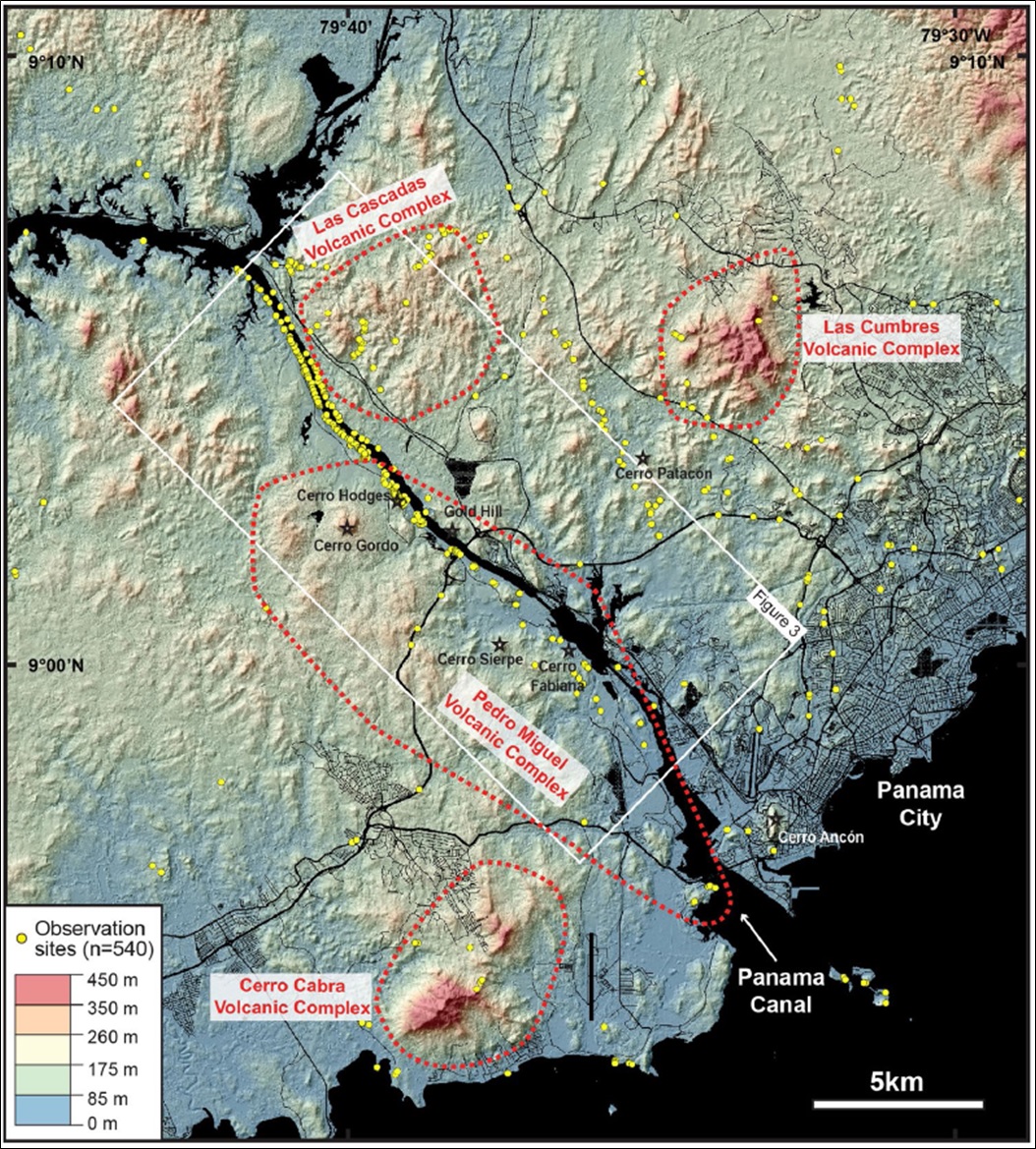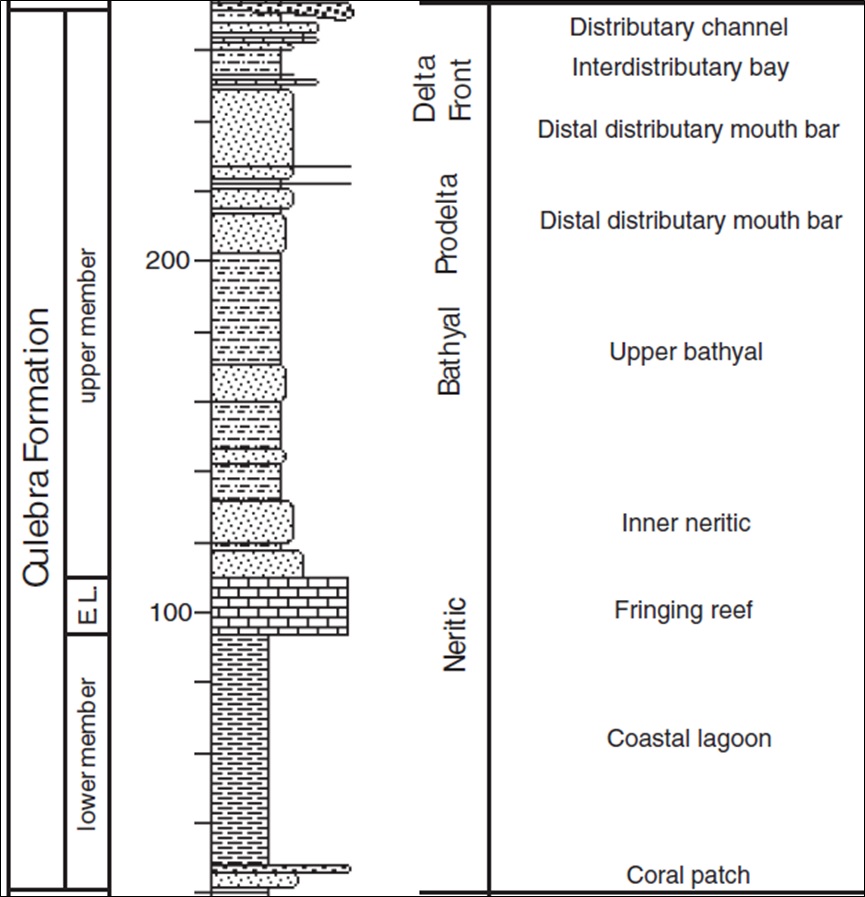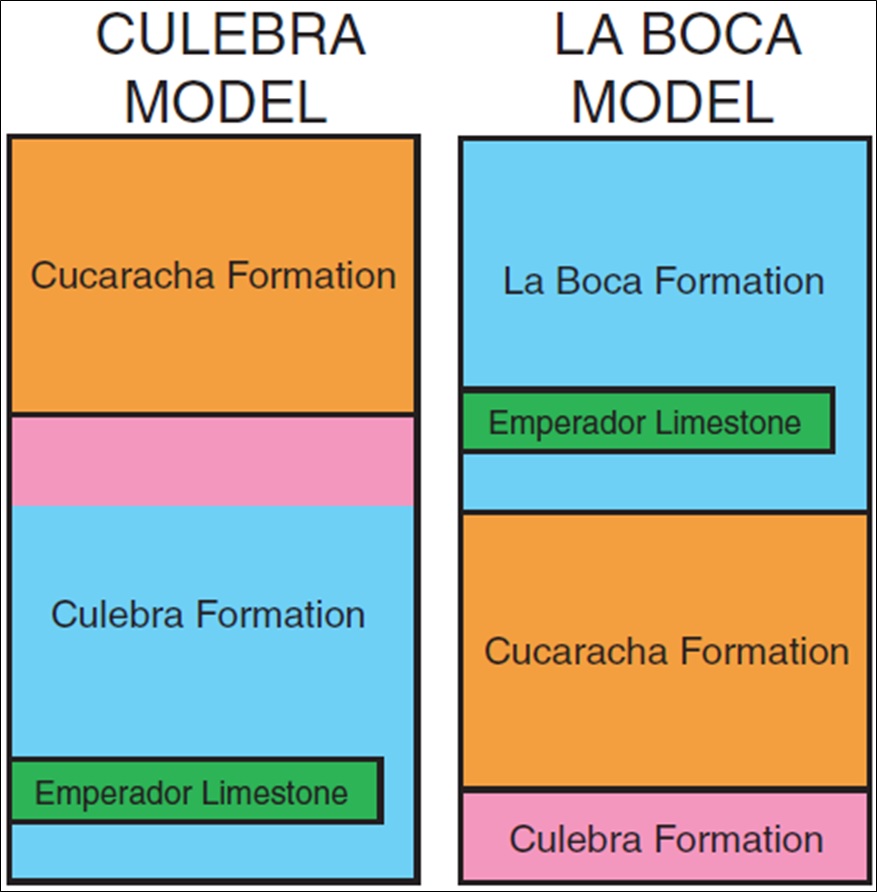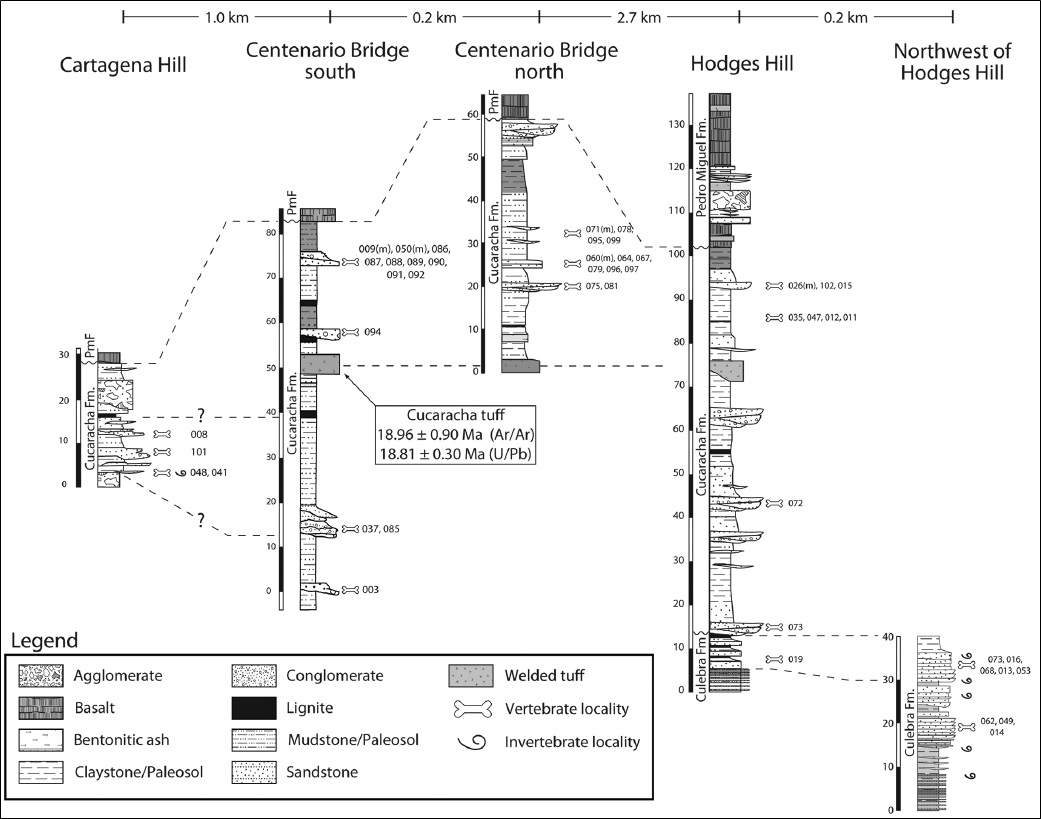Culebra Fm
Type Locality and Naming
The type region is Central Culebra Cut area, where the town of Culebra was located on west side of the canal during its construction (Fig.1).
[Figure: (left) Topography of the Central Panama in the southern Panama Canal area and its main volcanic complexes (Buchs et al. (2019)). Digital topography model based on Lidar survey by the Panama Canal Authority. The geological details of the area within the white rectangle (figure 3 of Buchs et al. (2019)) can be seen in right. (right) Geology of the southern part of the Panama Canal (Culebra Cut and new Pacific locks area). (A) Revised geological map. (B) Revised chronostratigraphic chart with previous and new geochronological constraints (new data in dark circles and bold text) (Buchs et al. (2019)).]
Synonym: Culebra Clays; Culebra Beds. Also, Kirby et al. (2008) re-interpreted what was called the ‘‘La Boca Fm’’ (with the Emperador Limestone) by earlier authors, as being the lower part of the Culebra Fm.
Lithology and Thickness
The Culebra Fm is comprised of a ~200 m thick section (Woodring (1957)) of mixed siliciclastic (organic rich black sandstones) and carbonate (mudstones) marine sediments. Early in its stratigraphic sequence there exist limestone and patchy coral reefs that are collectively referred to as the Emperador Limestone (Figure 2 (left)). Together with the predominantly terrestrial Cucaracha Fm, that conformably overlies it, they comprise what is thought to be a transgressive-regressive sequence with environments of deposition that include fringing reef, neritic, upper bathyal (Lower Culebra) (Figure 3 (right)) and lagoonal (Figure 3 (left)) to fluvial-deltaic (Upper Culebra-Cucaracha) (Uhen et al. (2010)) that likely included mangrove swamps in the near-shore areas and tropical forests Head et al. (2012). The Culebra Fm includes the nearshore, coralline Emperador Limestone Member and the upper bathyal La Boca unit (Blacut and Kleinpell (1969))
At Kirby et al. (2008)'s Las Cascadas locality (along the Culebra Cut), the Culebra Fm consists of nine facies (Figure 083).
BASE
- The lowermost facies in the Culebra Fm is a black lignitic mudstone bed, which lies conformably over paleosols of the Las Cascadas Fm.
- The lignitic mudstone bed is overlain by a medium-grained calcarenite and pebbly calcirudite. Both beds contain fragments of corals [Acropora saludensis Vaughan, 1919 and Montastraea imperatoris (Vaughan, 1919)], mollusks, echinoderms, and larger benthic foraminifera.
- These beds are overlain by a thick sequence of carbonaceous mudstone with thin tabular interbeds of fossiliferous lithic wacke. Bivalves, gastropods, and carbonized compressions of sea grasses and wood are common in the carbonaceous mudstone. Bottom contacts of the lithic-wacke beds with underlying mudstone are sharp and scoured, whereas upper contacts are gradational with overlying mudstone. Thalassinoides burrows are common in the mudstone beneath each lithic-wacke interbed and burrows are typically infilled with lithic wacke.
EMPERADOR LIMESTONE
- Overlying these beds are five facies of the Emperador Limestone. The first facies consists of a branching-coral boundstone containing nine species of coral with abundant Acropora saludensis and Montastraea canalis (Vaughan, 1919) dominating in a very fine-grained calcarenite matrix.
- The second facies consists of white, rhodolithic limestone. Algal rhodoliths range 1-4 cm in diameter.
- The third facies consists of branching-coral boundstone, including abundant Acropora salu-densis, Stylophora granulata Duncan, 1864, and Porites douvillei Vaughan, 1919 as part of a diverse assemblage containing 20 species of corals in a mud matrix. Isolated coral heads of Montastraea imperatoris are present in life position, especially near the contact with the underlying rhodolithic limestone. Thin interbeds (10 cm) of fine-grained calcarenite containing wavy bedding of mudstone are locally present in this facies.
- The fourth facies consists of platy-coral boundstone, which contains 18 species of coral.
- The fifth facies consists of calcirudite containing 17 species of corals in a calcarenite matrix. Displaced head corals of Montastraea species and massive Porites species are common.
TOP
- Alternating beds of sandstone and mudstone overlie the Emperador Limestone, and the sandstone beds become thinner and more fine-grained up-section. In contrast, the mudstone beds become thicker as one moves upsection (Figure 2 (left)). In addition, the sandstone beds grade up-section from a medium-grained calcarenite to a fine- grained lithic wacke, such that carbonate grains decrease in abundance up-section, whereas quartz and lithic grains increase up-section. There is also a lateral facies change between these two facies, such that the sandstone beds thin and pinch out and the grey mudstone beds thicken to the north over 1-2 km. The upper Culebra Fm, represented by a transition from predominant lithic wackes (lowermost upper Culebra Fm) to either amalgamated lenses of bioturbated litharenites or fining-upward sequences of conglomeratic to medium-grained litharenites, carbonaceous mudstones, and lignites (uppermost upper Culebra Fm), has been interpreted to indicate a regressive transition from shelf marine environments to estuarine and deltaic-front environments (Kirby et al. (2008); Pimiento et al. (2013b)).
The lowermost sandstone bed overlying the Emperador Limestone (medium-grained calcarenite) contains six species of corals and abundant mollusks (bivalves and gastropods). Massive Porites species and head corals of Montastraea canalis are clearly not in life position, as they show different orientations with respect to bedding. Mollusks remain common in the sandstone beds up-section, but corals decrease in abundance. The grey mudstone beds contain abundant mollusks, echinoids, shark teeth, bioturbation, and rare volcanic lithics. A white ash bed (4 cm thick) is present at the base of the second-highest sandstone bed. Although the sequence of the upper Culebra Fm has produced an abundant marine invertebrate fauna (Woodring (1982)), ichthyofauna (Pimiento et al. (2013b)), and occasional marine mammals (Uhen et al. (2010)), the conglomeratic litharenite strata have also yielded significant dental and post cranial elements of terrestrial mammals, including peccaries (tayassuids; MacFadden et al. (2010)), rhinocerotids, and extinct protoceratids.
Thickness: Thickness estimates for this unit also vary depending on how fault bounded stratigraphic sections are correlated. Kirby et al. (2008) suggests a unit thickness of >250 m based on the correlation of sections in the Hodges and Empire sectors of the Canal. Whereas, Montes et al. (2012b) suggest a minimum thickness of 88 m based on a contiguous section in the Hodges Hill sector. A Culebra Fm thickness of 130 m is used in the Figure 031 stratigraphic section. This thickness is constrained by drill cores from Lutton and Banks (1970), but it is a minimum. On the west side of the canal near the former site of the town of Las Cascadas (9°4'28"N; 79°40'31.1"W), the Culebra Fm is 150 m thick (Figure 2) (Johnson & Kirby (2006)), The top of the Culebra Fm was not seen.
[Figure2: (left) Stratigraphic section of the Culebra Fm along the Gaillard Cut, including paleoenvironmental interpretations. Kirby et al. (2008). E.L. = Emperador Limestone. (right) The sea cow (dugong) Culebratherium alemani being excavated along the Panama Canal. Barnes (2019) & Velez-Juarbe Jorge, Wood Aaron R. (2019).]
[Figure3: (left) Tuffaceous sediment in the lagoonal facies; Lower Member. Buchs et al. (2019). (right) Tuffaceous turbidites in a bathyal facies; lower Upper Mbr. Buchs et al. (2019)]
[Figure4: The two alternative stratigraphic models for the formations exposed along the Culebra Cut portion of the Panama Canal; the Culebra model (left) and the La Boca model (right). Equal color between the two models refer to the same stratigraphic unit. Kirby et al. (2008) confirm that the Culebra Model is the valid one and interpret the rock interval known as La Boca Fm in the Culebra Cut to be the lower part of the Culebra Fm. However, he does not go as far as naming this Lower Member the “La Boca Member” of the Culebra Fm.]
[Figure5: Stratigraphic correlations among MacFadden et al. (2014)’s measured sections containing the Centenario Fauna from the localities depicted in Figure 031. The Centenario Fauna extends from the lowest stratigraphic locality in the Culebra Fm, at 20m above the base of the measured section northwest of Hodges Hill to several localities at ∼75 m above the base of the measured section at Centenario Bridge (see also Kirby et al. (2008)). PmF = Pedro Miguel Fm; Fm = Formation.]
Relationships and Distribution
Lower contact
Upper contact
Regional extent
GeoJSON
Fossils
Age
Depositional setting
Additional Information
References:
- Jackson (1917); Pilsbry (1918); Rathbun (1918); Vaughan (1918); Cushman (1919); Vaughan (1924); Wilmarth (1938).
- Woodring and Thompson (1949) placed the "Emperador limestone Member" within the "Culebra Fm”. They estimated maximum thickness of about 500 feet. Conformably overlies Las Cascadas agglomerate; underlies Cucaracha Fm.
- Cork (1953); Woodring (1957, 1959).
- Woodring (1960). It unconformably overlies the Oligocene (?) Las Cascadas agglomerate. It consists of dark colored thin-bedded fine-grained rocks and calcareous sandstone, all tuffaceous. It is recognized only along and near the Canal. Its early Miocene age is based on foraminifera, corals, and mollusks. Part or all of the formation is considered late Oligocene by some paleontologists. The fossils include Lepidocyclina miraflorensis, L. waylandvaughani, Miogypsina cushmani, Amphisorus americanus, Turritella cf. subgrundifera, Orthaulax cf. aguadillensis, Anadara cf. chiriquensis, Macrocallista cf. maculata, Nemocardium cf. diversum, and Trachycardium cf. dominicense. Though the town of Culebra was headquarters during the construction of the canal, it is abandoned. For the location, on the west side of Culebra Cut, see Woodring (1957, p. 34), cited under the name.
- Blacut and Kleinpell (1969); Woodring (1964, 1970, 1973);
- Bold (1973) demonstrated that the restricted Culebra Fm is correlative with sections containing the Emperador Limestone and overlying sediments, based on ostracode biostratigraphy.
- Woodring (1982); Graham et al. (1985); Graham (1987); Graham (1988b); Collins et al. (1996); Johnson & Kirby (2006); Kirby et al. (2008); Cadena (2009); MacFadden et al. (2010); Montes et al. (2010); Uhen et al. (2010); Cadena et al. (2012); Head et al. (2012); Hastings et al. (2013); Pimiento et al., (2013b); MacFadden et al. (2014); Jaramillo et al. (2014); Rincon et al. (2015a, 2015b); Jud et al. (2016); Farris et al. (2017); Buchs et al. (2019); Velez-Juarbe & Wood (2019);




